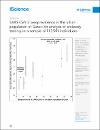SARS-CoV-2 seroprevalence in the urban population of Qatar: An analysis of antibody testing on a sample of 112,941 individuals
| المؤلف | Peter V., Coyle |
| المؤلف | Chemaitelly, Hiam |
| المؤلف | Ben Hadj Kacem, Mohamed Ali |
| المؤلف | Abdulla Al Molawi, Naema Hassan |
| المؤلف | El Kahlout, Reham Awni |
| المؤلف | Gilliani, Imtiaz |
| المؤلف | Younes, Nourah |
| المؤلف | Al Anssari, Ghada Ali A.A. |
| المؤلف | Al Kanaani, Zaina |
| المؤلف | Al Khal, Abdullatif |
| المؤلف | Al Kuwari, Einas |
| المؤلف | Butt, Adeel A. |
| المؤلف | Jeremijenko, Andrew |
| المؤلف | Kaleeckal, Anvar Hassan |
| المؤلف | Latif, Ali Nizar |
| المؤلف | Shaik, Riyazuddin Mohammad |
| المؤلف | Abdul Rahim, Hanan F. |
| المؤلف | Nasrallah, Gheyath K. |
| المؤلف | Yassine, Hadi M. |
| المؤلف | Al Kuwari, Mohamed Ghaith |
| المؤلف | Al Romaihi, Hamad Eid |
| المؤلف | Al-Thani, Mohamed H. |
| المؤلف | Bertollini, Roberto |
| المؤلف | Abu-Raddad, Laith J. |
| تاريخ الإتاحة | 2021-10-20T09:18:27Z |
| تاريخ النشر | 2021-06-25 |
| اسم المنشور | iScience |
| المعرّف | http://dx.doi.org/10.1016/j.isci.2021.102646 |
| الاقتباس | Coyle, P. V., Chemaitelly, H., Kacem, M. A. B. H., Al Molawi, N. H. A., El Kahlout, R. A., Gilliani, I., ... & Abu-Raddad, L. J. (2021). SARS-CoV-2 seroprevalence in the urban population of Qatar: An analysis of antibody testing on a sample of 112,941 individuals. Iscience, 102646. |
| الرقم المعياري الدولي للكتاب | 25890042 |
| الملخص | The study objective was to the assess level of detectable severe acute respiratory syndrome coronavirus 2 (SARS-CoV-2) antibodies in the urban population of Qatar. Antibody testing was performed on residual blood specimens for 112,941 individuals (∼10% of Qatar's urban population) attending for routine/other clinical care between May 12 and September 9, 2020. Seropositivity was 13.3% (95% confidence interval [CI] = 13.1–13.6%) and was independently associated with sex, age, nationality, clinical care encounter type, and testing date. Median optical density (antibody titer) among antibody-positive persons was 27.0 (range = 1.0–150.0), with higher values associated with age, nationality, clinical care encounter type, and testing date. Seropositivity by nationality was positively correlated with the likelihood of having higher antibody titers (Pearson correlation coefficient = 0.85; 95% CI = 0.47–0.96). Less than two in every 10 individuals in Qatar's urban population had detectable antibodies against SARS-CoV-2, suggesting this population is still far from herd immunity and at risk of subsequent infection waves. Higher antibody titer appears to be a biomarker of repeated exposures to the infection. |
| اللغة | en |
| الناشر | Elsevier |
| الموضوع | Health informatics Public health Infection control in health technology Immunology |
| النوع | Article |
| رقم العدد | 6 |
| رقم المجلد | 24 |
| Open Access user License | http://creativecommons.org/licenses/by/4.0/ |
تحقق من خيارات الوصول
الملفات في هذه التسجيلة
هذه التسجيلة تظهر في المجموعات التالية
-
أبحاث مركز البحوث الحيوية الطبية [833 items ]
-
العلوم الحيوية الطبية [845 items ]
-
أبحاث فيروس كورونا المستجد (كوفيد-19) [853 items ]
-
الصحة العامة [514 items ]



